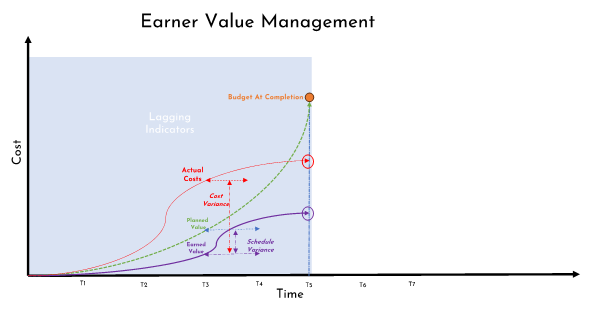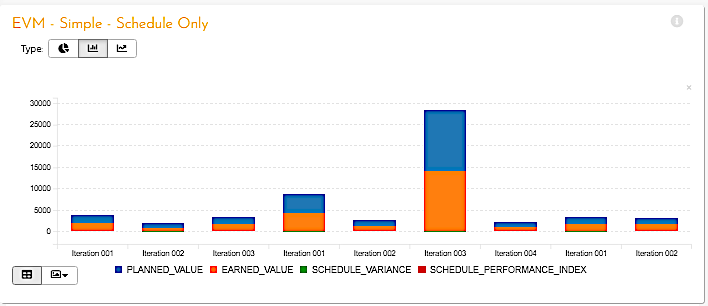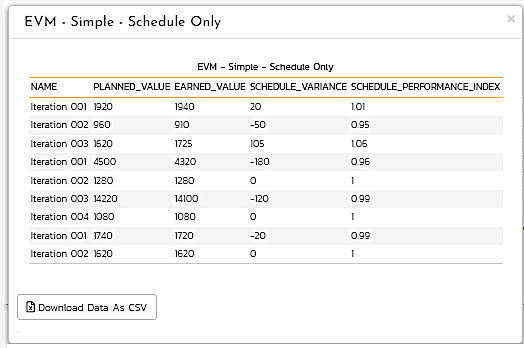Introduction
In today's competitive landscape, project management goes beyond merely tracking tasks and timelines. It's about having a 360-degree view of your project's health, aligning it with business objectives, and making data-driven decisions. Earned Value Management (EVM) is a cornerstone for this comprehensive approach regardless of the project delivery modalities.
This whitepaper explains how to implement EVM with SpiraPlan’s - Inflectra’s enterprise-level software development and Test Management solution.
If you're ready to experience the unparalleled capabilities of SpiraPlan, start your free trial today!
Section I: The Business Case for EVM in Project Management
Comprehensive Oversight for Business Health
EVM is a business health monitoring system. By integrating schedule and cost metrics with delivering on scope, EVM provides a comprehensive view of project and business health. EVM is particularly crucial for organizations looking to align individual project outcomes with broader strategic business objectives.
Data-Driven Decision-Making and KPIs
EVM operates on the basis of Key Performance Indicators (KPIs) that can be categorized as Lagging Indicators and Leading Indicators. While the lagging indicators tell how a project is performing, the leading indicators guide decision-making for the business to evaluate appropriate risk-driven change management required to bring the project on track or take other corrective actions.
The lagging indicators have a separate set of KPIs focusing on Schedule and Cost performance. Schedule Variance (SV) or Schedule Performance Index (SPI) can measure the schedule performance. When a project team tracks costs, the cost performance can be measured by either Cost Variance (CV) or Cost Performance Index (CPI).
Figure 1 – Lagging Indicators
The leading indicators forecast the required additional cost to meet the agreed-upon scope. Consequently, three different metrics are used. These are An Estimate To Complete (ETC), an Estimate At Completion (EAC), and the To-Complete-Performance Index (TCPI). The above KPIs enable project leads to align project outcomes with business goals.
Below is a short video demonstrating how all the above concepts come together to aid businesses in making data-driven decisions.
Enhanced Accountability and Transparency
EVM metrics serve as the empirical pillars supporting transparency, inspection, and adaptation. They offer a transparent view of project status, fostering a culture of accountability among team members. This transparency is beneficial for internal stakeholders and can be a selling point when communicating with clients or external stakeholders.
Resource Optimization for Business Scalability
EVM allows for dynamic resource allocation based on real-time project performance, ensuring optimal utilization of both human and material resources. This level of resource optimization is critical for business scalability and growth. At the program and portfolio levels, businesses are constantly evaluating benefit sustenance and value maximization. EVM metrics elevate risk-driven prioritization and opportunity cost evaluation in program and portfolio management, supporting program-related activities and portfolio optimization.
The Imperative for EVM in Regulated Industries
- Regulatory Oversight: Regulated industries operate under stringent guidelines that require meticulous documentation, traceability, auditing, and reporting. Failure to adhere to this material evidence can result in project termination and severe penalties, including fines, operational disruptions, and opportunity loss for the business.
- The Need for Accurate Metrics: In regulated industries, project management is a critical operation. The stakes are high, and the margin for error is low. EVM entails risk management thinking from both corrective and preventive action (CAPA) standpoints! Overall, EVM is a proven practical framework that provides a holistic view of project performance and business decision-making.
- Complexity and Risk: Projects in these sectors often involve multiple stakeholders, high financial stakes, and complex technical requirements. The risks are not just operational and are spread out through the project delivery life cycle involving many categories of risks.
Ready to unlock the full potential of Earned Value Management with Spira? Schedule a discovery call with your Account Manager to discuss how our suite of products can transform your project management approach.
Roles Responsible for EVM Project Managers and Spira's Role
Project Managers are generally the primary custodians of EVM, and SpiraPlan makes the role much more effective. Depending on the organization and the methodology practiced, the project manager role may be distributed or owned by business analysts, product owners, or scrum masters. The concepts for monitoring project health through EVM, therefore, extend equally well to include the requirements of these other roles.
New to EVM using Spira?
Contact Us and get expert guidance on implementing EVM in Spira effectively.
Section II: Implementing EVM with Spira
Step 1: Decide the EVM level to be tracked
Some projects require only tracking schedule performance as the resources are internally exempt employees or do not involve any direct costs. Some projects require costs to be tracked at the highest level without summarizing detailed costs at the task level. So, it is critical to understand how the business objectives are aligned with the project-level tracking.
In Spira, you can follow one of the three paths described below as we support different system setups and data-tracking during the project delivery life cycle.
- Track only Schedule Performance
- Track Schedule Performance with Cost Performance only at the summary level
- Track Schedule Performance and Cost Performance at the detailed level.
Step 2: System Setup in Spira
Spira delivers a comprehensive set of high-performance capabilities tailored for effective EVM implementation. With advanced features in both product and project management—ranging from end-to-end requirements management to strategic prioritization and full traceability—our suite empowers product managers to monitor development progress and accurately assess value delivery. This actionable insight facilitates well-informed decisions on feature prioritization and resource allocation.
One of the standout features of the Spira suite is its ability to integrate product and project management. This means EVM metrics can be rolled up from the task to the product level, providing a comprehensive view critical for strategic decision-making.
Customizable fields for Planned Value (PV), Earned Value (EV), and Actual Costs (AC) can be easily configured, allowing you to capture the necessary data for EVM calculations. Some organizations use a different set of terms. For instance, the planned value is also called the budgeted cost of work scheduled (BCWS), the earned value is also called the budgeted cost of work performed (BCWP), and the actual costs are also called sunk costs or actual cost of work performed (ACWP). The overall allocated planned budget is also called budget at completion (BAC).
- Scenario 1: As part of the project release module, Spira includes fields related to planned or estimated hours (PV) and projected or utilized hours (EV). These hours can be used to compute schedule performance (SV or SPI) without connecting with the cost considerations. This approach addresses the use case 1 in step 1.
Figure 2 - EVM Schedule Screenshot in SpiraPlan (Graph)
Figure 3 - EVM Schedule Screenshot in SpiraPlan, Spira Reporting
- Scenario 2: When costs are involved at the release level, custom properties can be added to track the summary costs. This cost could be the blended rate to report time in cost units and costs such as the non-human or indirect costs as accrued. This approach addresses the use case 2 in step 1.
- Scenario 3: When costs are getting granular at the individual task level rather than at the summary level, then these costs can be supported by the custom properties at the task level. This approach addresses the use case 3 in step 1. Since tasks are part of the SpiraTeam and SpiraPlan, this use case 3 does not apply to SpiraTest.
Step 3: Running Queries and Custom Reporting
Spira allows you to run custom SQL queries to calculate EVM metrics depending on the specific use case. These queries can be integrated into custom reports and shared with stakeholders for real-time insights.
Step 4: Results Interpretation and Action
Spira's reporting and graphing capabilities can be leveraged to report these EVM metrics. Visual graphs can be customized to show KPIs like CPI and SPI, providing actionable insights that can be used to steer the project in the right direction.
Convinced that EVM with Spira is the right fit for your organization?
Take the first step by signing up for a free trial. Experience firsthand how Spira can streamline your project management.
Section III: Implementing EVM using Spira
Part 1: Schedule Metrics in Spira
EVM in Spira can help you keep your projects on schedule. Our latest Knowledge Base article offers a practical guide on implementing EVM metrics specifically tailored for schedule tracking in SpiraPlan. This guide simplifies complex metrics like Schedule Variance (SV) and Schedule Performance Index (SPI) into easy-to-implement SQL queries.
The Approach:
- An in-depth explanation of the three core elements of EVM: Planned Value, Earned Value, and Actual Costs
- Insights into how Schedule Variance and Schedule Performance Index can tell you if your project is on track
- Ready-to-use SQL queries that provide a real-time snapshot of your project's schedule performance.
Don't let myths and misunderstandings about costs deter you; You can manage your project's schedule effectively even if you don't directly manage costs.
STEP-BY-STEP INSTRUCTIONS:
Implementing EVM - Schedule Metrics in Spira
Part 2: Schedule and Cost Metrics in Spira
You can step up your project management game by integrating cost metrics into your EVM framework with Spira. Understand where your project dollars are going with actionable insights that elaborate on essential schedule metrics and introduce game-changing cost metrics like Cost Variance and Cost Performance Index.
The Approach:
- A deep dive into three custom properties that are crucial for intelligent cost management: Non-Human Costs, Blended Rate, and Incurred Costs
- A step-by-step guide on setting these up at the release level in Spira, all in the same currency unit for uncompromised accuracy
- Custom SQL queries are tailored to help you compute these metrics to make data-backed decisions without breaking a sweat.
The Benefit: tracking human and non-human resources effectively, aggregating these costs at the release level, minimizing overhead, and maximizing clarity.
STEP-BY-STEP INSTRUCTIONS:
Implementing EVM - Schedule and Cost Metrics in Spira - Part 2
Part 3: Schedule and Summary of Task-Based Cost Metrics in Spira
Master EVM by leveraging the advanced features and analytics of the Inflectra products and position your projects and business for sustainable growth and market leadership. Spira offers you flexibility, control, transparency, heightened accountability, and data-backed decisions.
The Approach: A walk-through of how to deploy custom SQL queries to unlock advanced cost and schedule metrics - your secret sauce for smarter, faster, data-backed decision-making.
The Benefit: Spot-on budget management, no more missed deadlines, and the agility to navigate unexpected challenges.
STEP-BY-STEP INSTRUCTIONS:
Implementing EVM - Schedule and Summary of Task-Based Cost Metrics in Spira - Part 3
Learn more about EVM using Spira today:
Conclusion
Earned Value Management is not merely a methodology in project management but a critical tool for holistic project and business health monitoring. Its comprehensive, metrics-driven approach provides invaluable insights, enhances accountability, and facilitates better decision-making. Spira's suite of products offers a robust and integrated platform for implementing EVM, making it easier for organizations to manage projects effectively and align them with broader business objectives. Our products empower you to make data-backed decisions, ensuring transparency and accountability across projects. Whether in a regulated industry or a tech startup, Spira gives you the tools for effective project management.
It's time to elevate your approach to project management!
Arm yourself with Inflectra’s technological edge and align your project outcomes seamlessly with business objectives. The result? A healthier bottom line, optimal resource utilization, and a culture of continuous improvement and excellence.
Take the first step by signing up for SpiraPlan free trial:
For more information on how to implement EVM in your organization using Spira, feel free to contact us sales@inflectra.com








